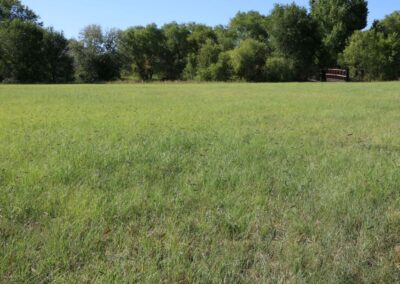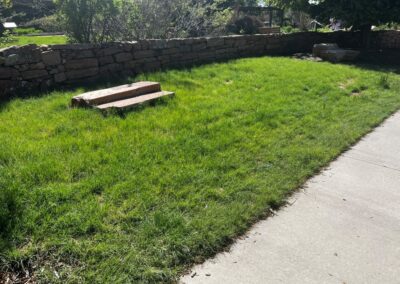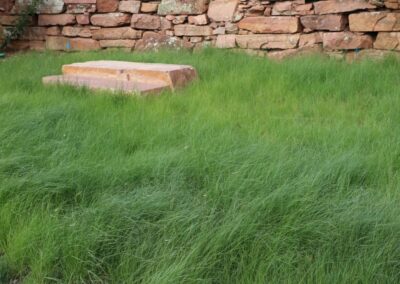Buffalo Grass/Blue Grama Grass Mix
Buffalo grass mixed with blue grama grass is a great option for hot, dry sites where the soil type, growing conditions, and mowing frequency vary.
Active Growth
April-October
Light Needs
Full Sun
Origin
Native
Best For:
- Landscapes with full sun
- Low-maintenance landscapes
- Sites with variations in soil texture
- Landscapes where the denser growth habit of buffalograss, plus the longer green season or seedheads of blue grama, is desired
- Landscapes that will have some mowed areas mowed and some unmowed areas
- Informal or naturalistic landscapes
Not Suited For:
- Shady locations
- Areas under large trees
- Sites where frequent mowing is required
- Elevations above 6,800 feet
- Sports fields or repetitive use areas
Tolerates: Hot, dry, sunny locations with a variety of soil types; drought
Irrigation need (FRONT RANGE)
No Irrigation
Turf Irrigation
Water Use: Requires about ⅓ of the water of a traditional lawn. Water once per week or less, May to October.
Using Buffalo Grass and Blue Grama Mixed
A mixture of buffalograss and blue grama grass offers a uniform appearance adaptable to different soil types and mowing frequencies. It needs at least six hours of sun to thrive. This combination grows in areas up to 6,800 feet in elevation. Above 6,800 feet, plant blue grama alone or mix it with a different grass since buffalograss will not thrive. These grasses turn green later in spring (April) and turn brown earlier in fall (late October) than a traditional lawn. They will tolerate moderate foot traffic, but aren’t suited to areas of intense, constant recreation.
Buffalo Grass/Blue Grama Mixture Attributes
- Combines the best characteristics of buffalograss and blue grama
- Provides a dense, uniform stand of grass for a lawn-like look
- More tolerant of frequent mowing than blue grama alone
- Blue-green in color with a leaf height of 6-12 inches and an overall height of 12-24 inches with seedheads
- Quick germination of blue grama can provide ground coverage sooner, showing early signs of success and providing competition against weeds
Installing Buffalo Grass and Blue Grama Grass Mixture
- Planted by seed
- The ideal seeding time is June 1 to July 31 when soil temperatures are 65 degrees or greater
- Seeded at a depth of 0.25-0.50 inches
- Seeding rate of 3 lbs per 1,000 square feet of area for landscape projects
- Mixing ‘Hachita’ blue grama and ‘Sundancer’ buffalograss has been successful in Colorado
- Blue grama seed is significantly lighter and smaller than buffalograss seed; a 50-50 mix by seed count may be 20% blue grama and 80% buffalograss by weight
Establishment
General
Buffalo grass/blue grama mixture is an excellent blend of native grasses for lawn replacement or a naturalistic area. The mixture takes advantage of the best characteristics of both grass varieties, including the spreading habit of buffalo grass and the longer green season, height, and beautiful seedheads of blue grama. This mixture provides management flexibility: it can be mowed like a traditional lawn or left tall for a more naturalistic look. It can also be a smart choice for areas where the soil texture varies or is unknown.
Weed Management
Buffalo grass/blue grama projects often have weeds, which should be controlled early to reduce competition for moisture and nutrients. Blue grama can be sensitive to many herbicides, so use a product like carfentrazone to control weeds soon after seedling emergence. Proactive weed management during establishment will result in healthy grass stands with minimal weed issues over time.
Watering for Establishment
Buffalo grass often takes three weeks to germinate, and it’s important to keep the soil moist until seedlings start to emerge even though the blue grama will germinate sooner.
Fertilizer During Establishment
Fertilizing new seedling stands helps them grow quickly so that their leaves fully cover the soil. Apply a controlled-release or organic fertilizer at planting OR fertilize regularly with a very light dose of quickly available fertilizer. A light dose of fertilizer can be applied as often as weekly, but at a significantly lower rate than standard lawn fertilization. Apply 0.1-0.2 pounds of nitrogen per 1,000 square feet each time the area is fertilized during the establishment period. Do not fertilize after mid-August.
Mowing During Establishment
Mowing a buffalo grass/blue grama mix periodically during establishment can improve its uniformity, manage taller weeds, and create a better appearance until it fills in. Once it reaches 5-7 inches tall, mow it as high as possible, ideally so the grass is 4-6 inches tall after mowing.
Long-Term Watering
Once established, buffalo grass and blue grama grass mixtures needs 8-10 inches of supplemental irrigation or less per growing season. This means watering once per week or less from May to October, and not watering at all during the winter when the grass is dormant (brown). More frequent watering will cause the blue grama to grow taller. To keep it shorter, water less often.
Once the grass has matured, schedule irrigation to meet your project goals and desired grass appearance. Overwatering results in increased weed competition and encourages cool-season grass invasion.
Mowing
A buffalo grass/blue grama mixture can either be mowed like a traditional lawn or left tall for a more naturalistic look. In fact, part of the area can be mowed while another section can be left unmowed.
Mow the stand low in late winter to remove the previous year’s growth for a greener, more uniform look throughout the growing season.
Weed Control
Weeds in a buffalograss/blue grama stand should be treated like a blue grama area. Blue grama can be sensitive to herbicides, and most herbicides are not tested for safety on blue grama.
Fertilizing
For areas where buffalo grass and blue grama is used as a lawn replacement or a low-water groundcover, fertilize once or twice in June or July when the grass is growing rapidly. Apply nitrogen at 1 lb/1000 square feet of area. Low-input, naturalized, or restored areas do not need to be fertilized at all, but may be less dense and develop some spaces between plants over time.
Start your project
Discover how to plan and implement a native grass project for long-term success.




